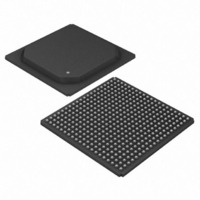DS33R41+ Maxim Integrated Products, DS33R41+ Datasheet - Page 80

DS33R41+
Manufacturer Part Number
DS33R41+
Description
IC TXRX ETHERNET MAP 400-BGA
Manufacturer
Maxim Integrated Products
Type
Transceiverr
Datasheet
1.DS33R41.pdf
(335 pages)
Specifications of DS33R41+
Number Of Drivers/receivers
4/4
Protocol
T1/E1/J1
Voltage - Supply
3.14 V ~ 3.47 V
Mounting Type
Surface Mount
Package / Case
400-BGA
Lead Free Status / RoHS Status
Lead free / RoHS Compliant
- Current page: 80 of 335
- Download datasheet (2Mb)
10.9 Signaling Operation
There are two methods to access receive signaling data and provide transmit signaling data, processor-based
(software-based) or hardware-based. Processor-based refers to access through the transmit and receive signaling
registers RS1–RS16 and TS1–TS16. Hardware-based refers to the TSIG and RSIG pins. Both methods can be
used simultaneously.
Figure 10-3. Simplified Diagram of Receive Signaling Path
10.9.1 Processor-Based Receive Signaling
The robbed-bit signaling (T1) or TS16 CAS signaling (E1) is sampled in the receive data stream and copied into
the receive signaling registers, RS1–RS16. In T1 mode, only RS1–RS12 are used. The signaling information in
these registers is always updated on multiframe boundaries. This function is always enabled.
10.9.1.1 Change-of-State
To avoid constant monitoring of the receive signaling registers, the transceiver can be programmed to alert the
host when any specific channel or channels undergo a change of their signaling state. TR.RSCSE1–TR.RSCSE4
for E1 and TR.RSCSE1–TR.RSCSE3 for T1 are used to select which channels can cause a change-of-state
indication. The change-of-state is indicated in status register 5 (TR.SR1.5). If signaling integration (TR.CCR1.5) is
enabled, then the new signaling state must be constant for three multiframes before a change-of-state is indicated.
The user can enable the INT pin to toggle low upon detection of a change in signaling by setting the TR.IMR1.5 bit.
The signaling integration mode is global and cannot be enabled on a channel-by-channel basis.
The user can identity which channels have undergone a signaling change-of-state by reading the TR.RSINFO1–
TR.RSINFO4 registers. The information from these registers inform the user which TR.RSx register to read for the
new signaling data. All changes are indicated in the TR.RSINFO1–TR.RSINFO4 registers regardless of the
TR.RSCSE1–TR.RSCSE4 registers.
RECEIVE SIGNALING
CHANGE-OF-STATE
T1/E1 DATA STREAM
EXTRACTION
REGISTERS
SIGNALING
INDICATION
REGISTERS
ALL-ONES
80 of 335
REINSERTION
SIGNALING
CONTROL
BUFFERS
PER-CHANNEL
CONTROL
RSERO
RSYNC
RSIG
Related parts for DS33R41+
Image
Part Number
Description
Manufacturer
Datasheet
Request
R

Part Number:
Description:
MAX7528KCWPMaxim Integrated Products [CMOS Dual 8-Bit Buffered Multiplying DACs]
Manufacturer:
Maxim Integrated Products
Datasheet:

Part Number:
Description:
Single +5V, fully integrated, 1.25Gbps laser diode driver.
Manufacturer:
Maxim Integrated Products
Datasheet:

Part Number:
Description:
Single +5V, fully integrated, 155Mbps laser diode driver.
Manufacturer:
Maxim Integrated Products
Datasheet:

Part Number:
Description:
VRD11/VRD10, K8 Rev F 2/3/4-Phase PWM Controllers with Integrated Dual MOSFET Drivers
Manufacturer:
Maxim Integrated Products
Datasheet:

Part Number:
Description:
Highly Integrated Level 2 SMBus Battery Chargers
Manufacturer:
Maxim Integrated Products
Datasheet:

Part Number:
Description:
Current Monitor and Accumulator with Integrated Sense Resistor; ; Temperature Range: -40°C to +85°C
Manufacturer:
Maxim Integrated Products

Part Number:
Description:
TSSOP 14/A°/RS-485 Transceivers with Integrated 100O/120O Termination Resis
Manufacturer:
Maxim Integrated Products

Part Number:
Description:
TSSOP 14/A°/RS-485 Transceivers with Integrated 100O/120O Termination Resis
Manufacturer:
Maxim Integrated Products

Part Number:
Description:
QFN 16/A°/AC-DC and DC-DC Peak-Current-Mode Converters with Integrated Step
Manufacturer:
Maxim Integrated Products

Part Number:
Description:
TDFN/A/65V, 1A, 600KHZ, SYNCHRONOUS STEP-DOWN REGULATOR WITH INTEGRATED SWI
Manufacturer:
Maxim Integrated Products

Part Number:
Description:
Integrated Temperature Controller f
Manufacturer:
Maxim Integrated Products

Part Number:
Description:
SOT23-6/I°/45MHz to 650MHz, Integrated IF VCOs with Differential Output
Manufacturer:
Maxim Integrated Products

Part Number:
Description:
SOT23-6/I°/45MHz to 650MHz, Integrated IF VCOs with Differential Output
Manufacturer:
Maxim Integrated Products

Part Number:
Description:
EVALUATION KIT/2.4GHZ TO 2.5GHZ 802.11G/B RF TRANSCEIVER WITH INTEGRATED PA
Manufacturer:
Maxim Integrated Products

Part Number:
Description:
QFN/E/DUAL PCIE/SATA HIGH SPEED SWITCH WITH INTEGRATED BIAS RESISTOR
Manufacturer:
Maxim Integrated Products
Datasheet:










